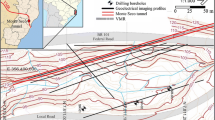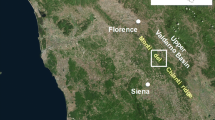Abstract
The latest technological developments in computer vision allow the creation of georeferenced, non-immersive desktop virtual reality (VR) environments. VR uses a computer to produce a simulated three-dimensional world in which it is possible to interact with objects and derive metric and thematic data. In this context, modern geomatic tools enable the remote acquisition of information that can be used to produce georeferenced high-definition 3D models: these can be used to create a VR in support of rock mass data processing, analysis, and interpretation. Data from laser scanning and high quality images were combined to map deterministically and characterise discontinuities with the aim of creating accurate rock mass models. Discontinuities were compared with data from traditional engineering-geological surveys in order to check the level of accuracy in terms of the attitude of individual joints and sets. The quality of data collected through geomatic surveys and field measurements in two marble quarries of the Apuan Alps (Italy) was very satisfactory. Some fundamental geotechnical indices (e.g. joint roughness, alteration, opening, moisture, and infill) were also included in the VR models. Data were grouped, analysed, and shared in a single repository for VR visualization and stability analysis in order to study the interaction between geology and human activities.













Similar content being viewed by others
References
Abellàn A, Oppikofer T, Jaboyedoff M, Rosser NJ, Lim M, Lato MJ (2014) Terrestrial laser scanning of rock slope instabilities. Earth Surf Proc Land 39:80–97
Assali P, Grussenmeyer P, Villemin T, Pollet N (2014) Surveying and modeling of rock discontinuities by terrestrial laser scanning and photogrammetry: semi-automatic approaches for linear outcrop inspection. J Struct Geol 66:102–114
Barton NR (1973) Review of a new shear strength criterion for rock joints. Eng Geol 7:287–332
Bellian JA, Kerans C, Jennette DC (2005) Digital outcrop models: applications of terrestrial scanning lidar technology in stratigraphic modeling. J Sediment Res 75(2):166–176
Beshr AAA, Elnaga IMA (2011) Investigating the accuracy of digital levels and reflectorless total stations for purposes of geodetic engineering. Alex Eng J 50:399–405
Bieniawski ZT (1989) Engineering rock mass classifications. Wiley, New York, p 272
Brady BHC, Brown ET (1994) Rock mechanics for underground mining. Chapman & Hall, London, p 571
Buckley S, Howell J, Enge H, Kurz T (2008) Terrestrial laser scanning in geology: data acquisition, processing and accuracy considerations. J Geol Soc 165(3):625–638
Carmignani L, Fantozzi PL, Giglia G, Meccheri M (1993) Pieghe associate alla distensione duttile del complesso metamorfico apuano. Mem Soc Geol Italiana 49:99–124
Carmignani L, Conti P, Fantozzi PL, Mancini S, Massa G, Molli G, Vaselli L (2007) I marmi delle Alpi Apuane. Geoitalia 21:19–30
Coli M, Grandini G, Matteini L (1987) Carta Strutturale del bacino marmifero di Orto di Donna (Alpi Apuane), 1:5000. SELCA, Firenze
Deere DUR, Miller P (1966) Engineering classification and index properties for intact rock. Technical Report AFNL-TR-65-116, National Technical Information Service, Air Force Weapons Laboratory, New Mexico, pp 300
Deliormanli AH, Maerz NH, Otoo J (2014) Using terrestrial 3D laser scanning and optical methods to determine orientations of discontinuities at a granite quarry. Int J Rock Mech Min 66:41–48
Fanti R, Gigli G, Lombardi L, Tapete D, Canuti P (2013) Terrestrial laser scanning for rockfall stability analysis in the cultural heritage site of Pitigliano (Italy). Landslides 10(4):409–420
Fekete S, Diederichs M, Lato M (2010) Geotechnical and operational applications for 3-dimensional laser scanning in drill and blast tunnels. Tunn Undergr Space Technol 25:614–628
Forzini C (2014) Analisi della fratturazione nei versanti in roccia a partire da dati laser scanner terrestre. Sperimentazione di differenti software per l’estrazione semi-automatica dei dati di giacitura. Dissertation, University of Siena
Francioni M, Salvini R, Stead D, Litrico S (2014) A case study integrating remote sensing and distinct element analysis to quarry slope stability assessment in the Monte Altissimo area, Italy. Eng Geol 183:290–302
Francioni M, Salvini R, Stead D, Giovannini R, Riccucci S, Vanneschi C, Gullì D (2015) An integrated remote sensing-GIS approach for the analysis of an open pit in the Carrara marble district, Italy: slope stability assessment through kinematic and numerical methods. Comput Geosci 67:46–63
Gigli G, Casagli N (2011) Semi-automatic extraction of rock mass structural data from high resolution LIDAR point clouds. Int J Rock Mech Min 48:187–198
Goodman RE (1989) Introduction to rock mechanics, 2nd edn. Wiley, New York, p 562
Hartzell PJ, Glennie CL, Finnegan DC (2013) Calibration of a terrestrial full waveform laser scanner. In: Conference American Society of Photogrammetry and Remote Sensing (ASPRS), Baltimore, Maryland, p 7
Jähne B, Haußecker H (2000) Computer vision and applications: a guide for students and practitioners. Academic Press, New York, p 679
Kemeny J, Post R (2002) Estimating three-dimensional rock discontinuity orientation from digital images of fracture traces. Comput Geosci 29:65–77
Kemeny J, Turner K, Norton B (2006) LIDAR for rock mass characterization: hardware, software, accuracy and best-practices. In: Tonon F, Kottenstette JT (eds) Proceedings of the Laser and Photogrammetric Methods for Rock Face Characterization, American Rock Mechanics Association, Alexandria, pp 49–62
Lato MJ, Voge M (2012) Automated mapping of rock discontinuities in 3D lidar and photogrammetry models. Int J Rock Mech Min Sci 54:150–158
Lato M, Diederichs MS, Hutchinson DJ, Harrap R (2009) Optimization of LiDAR scanning and processing for automated structural evaluation of discontinuities in rockmasses. Int J Rock Mech Min 46:194–199
Lato M, Diederichs MS, Hutchinson DJ (2010) Bias correction for static LiDAR scanning of rock outcrops for structural characterization. Rock Mech Rock Eng 23:615–628
Leica Geosystems (2015a) Cyclone external camera workflow-Nodal Ninja bracket. http://scansw.leica-geosystems.com/public/camera/. Accessed 03 February 2015
Leica Geosystems (2015b) Leica TruView Accuracy. http://leica-geosystems.com/downloads123/hds/general/cyclone/white-tech-paper/Leica_Truview_Accuracy_us.pdf. Accessed 25 March 2015
Lerma García JL, Van Genechten B, Heine E, Santana Quintero M (2008) Theory and practice on Terrestrial Laser Scanning. Editorial de la Universidad Politécnica de Valencia, Valencia, p 261
Maerz NH, Otoo JN (2014) Integrating discontinuity trace and facet orientation measurements for improved discontinuity data analysis. Int J Rock Mech Min Sci 72:300–303
Mah J, Samson C, McKinnon SD (2011) 3D laser imaging for joint orientation analysis. Int J Rock Mech Min Sci 48:932–941
Pejic M (2013) Design and optimisation of laser scanning for tunnels geometry inspection. Tunn Undergr Space Technol 37:199–206
Priest SD (1993) Discontinuity analysis for rock engineering. Chapman and Hall, London, p 473
Riquelme AJ, Abellán A, Tomás R, Jaboyedoff M (2014) A new approach for semi-automatic rock mass joints recognition from 3D point clouds. Comput Geosci 68:38–52
Salvini R (2014) Developments in UAV and LiDAR technology, data acquisition and processing. In: Stead D, Elmo D (eds) Short course on data collection for discrete fracture networks, 1st International conference on discrete fracture network engineering, Vancouver, British Columbia, Canada, p 55
Salvini R, Francioni M, Riccucci S, Bonciani F, Callegari I (2013) Photogrammetry and laser scanning for analyzing slope stability and rock fall runout along the Domodossola-Iselle railway, the Italian Alps. Geomorphology 185:110–122
Salvini R, Mastrorocco G, Vanneschi C, Riccucci S, Francioni M, Stead D (2014) Excavation stability analysis in an underground marble quarry in the Apuan Alps (Italy): application of terrestrial LIDAR, conventional methods and numerical modeling. In: Kennard D, Stead D, Eberhardt E, Elmo D (eds) Proceedings of the 1st international conference on discrete fracture network engineering, Vancouver, October 19–22, p 11
Slob S, Van Knapen B, Hack R, Turner K, Kemeny J (2005) Method for automated discontinuity analysis of rock slopes with three-dimensional laser scanning. Transp Res Rec 1913:187–194
Strouth A, Eberhardt E (2005) The use of LIDAR to overcome rock slope hazard data collection challenges at Afternoon Creek, Washington. In: Proceedings of the 41st US Symposium on Rock Mechanics, American Rock Mechanics Association, Golden, Colorado, June 17–21, p 12
Sturzenegger M, Stead D (2009) Close-range terrestrial digital photogrammetry and terrestrial laser scanning for discontinuity characterization on rock cuts. Eng Geol 103:163–182
Sturzenegger M, Stead D, Elmo D (2011) Terrestrial remote sensing-based estimation of mean trace length, trace intensity and block size/shape. Eng Geol 119:96–111
Vanneschi C, Salvini R, Massa G, Riccucci S, Borsani A (2014) Geological 3D modeling for excavation activity in an underground marble quarry in the Apuan Alps (Italy). Comput Geosci 69:41–45
Vasuki Y, Holden EJ, Kovesi P, Micklethwaite S (2014) Semi-automatic mapping of geological Structures Using UAV-based photogrammetric data: an image analysis approach. Comput Geosci 69:22–32
Voge M, Lato MJ, Diederichs MS (2013) Automated rockmass discontinuity mapping from 3-dimensional surface data. Eng Geol 164:155–162
Vosselman G, Hans-Gerd M (2010) Airborne and terrestrial laser scanning. Whittles Publishing, Dunbeath
Acknowledgements
The authors gratefully acknowledge the assistance of the personal of the Romana Quarry and particularly Corniani M. This paper was possible because of support from the Tuscany Region Research Project known as “Health and safety in the quarries of ornamental stones—SECURECAVE”. The authors acknowledge Pellegri M and Gullì D (Local Sanitary Agency n.1, Mining Engineering Operative Unit—Department of Prevention) and Riccucci S (Centre of GeoTechnologies, University of Siena) for their support of this research.
Author information
Authors and Affiliations
Corresponding author
Rights and permissions
About this article
Cite this article
Mastrorocco, G., Salvini, R. & Vanneschi, C. Fracture mapping in challenging environment: a 3D virtual reality approach combining terrestrial LiDAR and high definition images. Bull Eng Geol Environ 77, 691–707 (2018). https://doi.org/10.1007/s10064-017-1030-7
Received:
Accepted:
Published:
Issue Date:
DOI: https://doi.org/10.1007/s10064-017-1030-7




